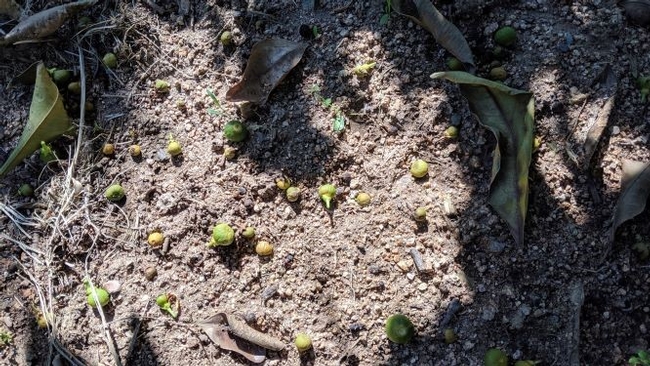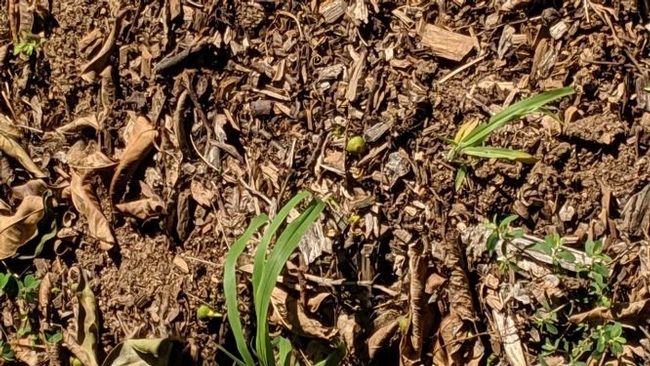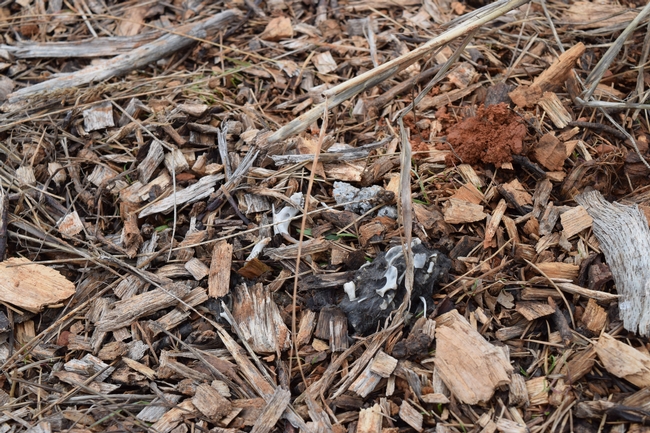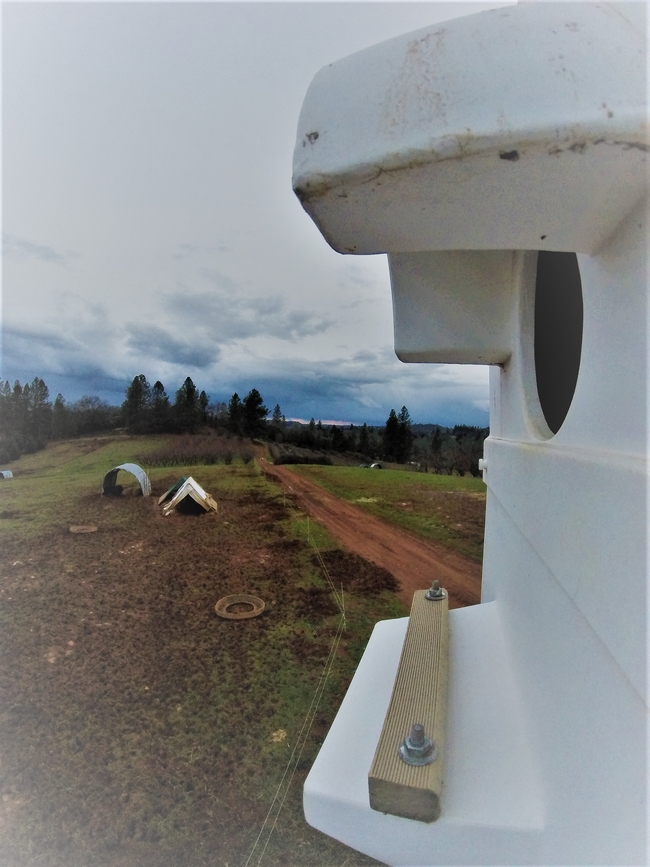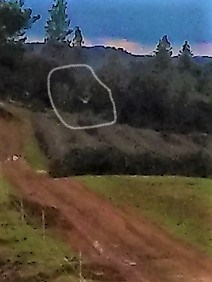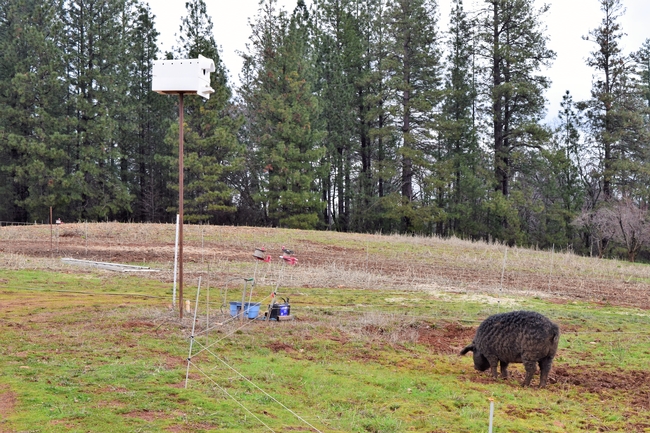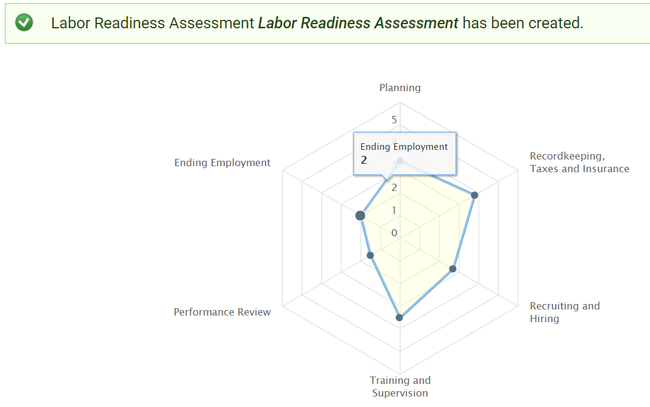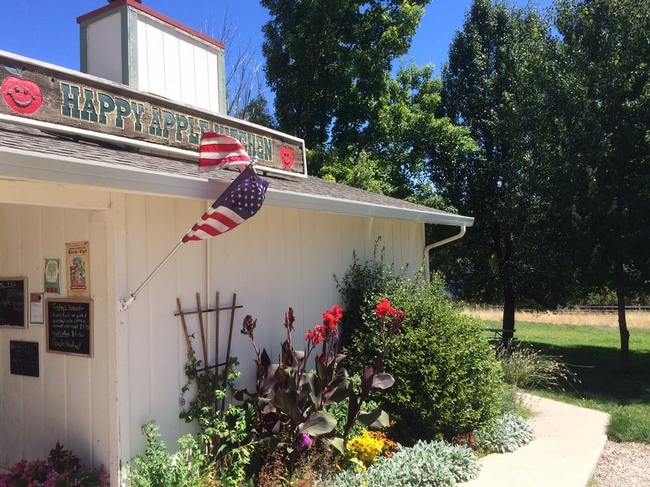Foothill Farming Blog
Public Safety Power Shutoffs - How is YOUR Farm Coping?
Over the weekend, much of the Sierra foothills was impacted by another PG&E Public Safety Power Shutoff (or PSPS, as the company calls it). This time, the advertised windstorm actually materialized - and while shutting off the electrical grid probably made sense from a wildfire prevention perspective, PG&E's actions had unforeseen consequences for many foothill farms and ranches.
For customers of the Placer County Water Agency, the power shutoff meant no American River water during an especially dry period. Citrus growers, especially, are entering a critical timeframe in the ripening of this year's mandarin crop. Many livestock producers rely on winter water during this time frame to provide drinking water for livestock - others pump groundwater for livestock (which is difficult without electricity). This evening, I'm filling a water tank in the back of my truck to haul water to our sheep in the morning.
But water (or the lack thereof) isn't the only challenge. Talking with Bob Bonk of Snow's Citrus Court this morning, I realized that growers who require cold storage where especially hard hit. Bob reported that he'd exceeded his fuel budget keeping generators running over the weekend. He'd also exceeded his capital purchase budget buying an additional generator. These added costs are difficult to anticipate, but necessary to staying in business. Bob also reported that many direct-market vegetable growers lost product without cold storage. Some growers who couldn't pump groundwater were not able to wash their produce.
Finally, I received a notice from my cellular provider late yesterday that I'd burned through most of my data for the month. Like many other producers, I imagine, I had turned to my cell phone to keep up with weather and fire conditions, information from PG&E, and other local news. All of these costs add up!
In the coming week, we will be working on a survey to document impacts to farmers and ranchers - we hope you'll take a few minutes while the memory of these recent outages is fresh to share your story. And over the winter months, we'll be working with the agricultural community to develop plans for dealing with these challenges in the future. Stay tuned!
Observations on Mandarin Mulching Research
Two years ago, UCCE Placer/Nevada embarked on a study to evaluate pruning and mulching in five local mandarin orchards. In a blog posted in June 2017, I discussed the beginnings of the study, the specific treatments and what the study was hoping to accomplish in the coming years. As the study enters the third year and data analysis begins, there are some observations that we should share.
The environment in our orchards is changing. We are experiencing unpredictable temperature swings and extreme periods of rainfall. Soil moisture levels this past winter and spring reached saturation levels for a prolonged period.
Roots need both water and oxygen. In saturated soils, oxygen in the soil pore spaces is displaced by water. This year, tree stress increased as the roots struggled to breathe. When root cells can't get oxygen, they die. Without them, the rest of the tree starts to die too. Many of us suffered tree loss due to the suffocation of root systems.
As orchards and fields began to dry, temperatures began to swing from high to low in unpredictable patterns. Stress was further introduced into the system. In the past few weeks, recorded temperatures in the five orchards have gone from lows in the 40's to recorded highs of 105 in the first few weeks of June. Citrus has a tendency to drop fruit that the tree cannot support and increased tree stress can increase fruit drop.
Field observations over the past few weeks show that drop is occurring at a much higher rate and volume in treatments that haven't been mulched. The picture on the left is from underneath the canopy of a tree without mulch (Control) and to the right is a mulched tree. These two trees are in the same orchard, approximately 18 feet apart.
Soil moisture levels are being monitored under both of these trees. Moisture levels under the mulched tree are consistent with what one would expect. The soil profile is able to retain moisture with minimal depletion at a 6-12” depth. Most moisture depletion is occurring in the top 6” of soil and is minimal compared to the Control. Moisture levels in the Control deplete at a more rapid rate throughout the soil to a depth of 12”. Once again, tree stress is on the rise. The soil moisture in the Control profile becomes much harder to replenish, resulting in longer irrigation cycles.
Soil temperature at a depth of 9” is also being monitored. Data from the Control show rather significant increases and decreases in temperatures in short periods of time. Data from the mulched tree reflect more temperature stability with the highs lower than those in the Control soil. Again, it seems that the Control may be under more stress due to the rapid temperature swings that the root mass is encountering.
It would certainly seem that a cursory examination of the data with field observations shows that mulching is a beneficial production practice in an orchard. However, there are some considerations to be had before one just charges ahead with this practice.
First, as we learned, timing is everything. Mulch should only be applied when the moisture in the soil profile is at capacity. Experience has taught us that applying the mulch when soil moisture is low results in playing catch up. I have observed orchards that were never able to replenish the full soil moisture content during the irrigation season.
Second, monitoring soil moisture is important. Mulching will change your irrigation timing and frequency. In our study, the period between irrigation cycles in mulched orchards has increased. Maturation appeared to be slowed in orchards that chose to stay with their old programs and not effectively monitor the soil moisture. Mulch reduces moisture loss from the soil, so if irrigation was not adjusted, the soil under the mulch stayed too wet. While less dramatic than the saturated soil situation this spring, stress was induced by the tree roots struggling to obtain oxygen and maturation slowed.
Certainly, mulching requires a little more effort on the grower's part. But is the not the reduction or control of the stress induced in the growing system beneficial to the entire orchard system? As a grower, I know that adding a little bit of stress into my trees at the right time and conditions is good for the fruit. Adding that stress at a time when it will not damage the tree or cause crop loss is key. Mulching certainly seems to mitigate stress in the growing system when stress is detrimental to the crop and system. Further data analysis will also provide us with more insight into the benefits that the mulch provides to the soil biology and composition. We will share those insights as they become available.
Barn Owls: Biological Control
I usually enjoy life and growing things as a farmer, however I was excited in the recent weeks to see the remains of something most definitely dead; owl pellets under an artificial nesting site. After a couple barn owl boxes were installed last year, I have eagerly awaited their occupation. Did you know that a family of barn owls will eat about 1,000 rodents in a single nesting season?
The recent owl pellet observation sparked my interest in researching the benefits of barn owls in agriculture. I found lots of information but focused on a particularly good peer-reviewed article called Agriculture land use, barn owl diet, and vertebrate pest control implications. (Kross, 2016). I will share with you the highlights, but you might want to read the research report yourself.
Research of owl presence at 25 California nesting boxes located mainly on row crops and perennial crops and forage, identified 1044 prey species. Pocket gophers, mice, and voles are generally the most important parts of the barn owl diet. Gopher numbers were highest in owl pellets found near perennial cropping systems but still a significant part of pellets found in annual cropping systems. Although mice are often considered less important as pests than gophers, they can carry pathogens that are a food-safety risk. 99.5% of prey items studied were agriculture pests, therefore owls are likely to provide valuable pest control services for farmers in our area if owl populations are fostered. Barn owls can persist if nesting sites and prey are available. Farmers seem to help provide the rodents, but let's not forget the nesting sites!
Alternative methods for rodent control such as trapping and poisoning can be expensive, labor intensive, and impact non-target species. Installation of nesting boxes to attract barn owls is not a proven method for sustained rodent control in agriculture systems by itself, rather it is best included as a component in an integrated pest management plan. Availability of nests sites appears to be the limiting factor of barn owl population growth in habitats that interface with humans (i.e. Farms and Ranches). Barn owls in the studied area occupied over half of the artificial nesting sites available to them, so installing nest boxes on farms may increase the natural barn owl rodent control.
Take away:
Farmers and ranchers who wish to utilize the low-cost natural predation of rodent pests by barn owls in their agriculture systems or simply attract owls should:
- Provide abundant nest sites, including nest boxes. Funding and plans may be found through contacting your local resource conservation district.
- Increase crop type diversity in proximity to nest sites to include both perennial and annual systems to increase owl hunting efficiency.
- Install nest boxes now for this spring nesting season for best chance of owl occupation in the next 6 months.
Resources:
Read the research article discussed above:
Kross S., Bourbour R., & Mertinico B. 2016. Agriculture land use, barn owl diet, and vertebrate pest control implications. Agriculture Ecosystems and Environment. 223, 167-174. http://sarakross.weebly.com/uploads/8/6/7/7/8677631/kross_bourbour___martinico_2016.pdf
NRCS Barn Owl Information Sheet and Owl box plans https://www.nrcs.usda.gov/Internet/FSE_DOCUMENTS/nrcs144p2_063925.pdf
UC Master Gardener Gopher Blog post, ideas for gopher management with great photos https://ucanr.edu/blogs/blogcore/postdetail.cfm?postnum=29485
UCANR Songbird, Bat, and Owl Houses https://anrcatalog.ucanr.edu/Details.aspx?itemNo=21636 This handy guide explores the benefits of the biodiversity and aesthetics of songbirds, bats, and owls. While written with vineyard managers in mind, anyone interested in learning about nest boxes will find this guide useful. Purchase this booklet at the link above for $15.
Everything You Want to Know About Labor but Are Afraid to Ask
Have you completed a cash flow analysis?
Cash flow is not profitability, it is the statement of incoming dollars and outgoing dollars at different times of the year, which results in a cash flow statement. Analyzing your cash flow will help determine if you are able to pay your employees throughout the year, seasonally, or if a budget needs to be made to ensure cash is available when needed.
Have you calculated the full cost of employees you want to hire?
The minimum hourly wage has increased but that still doesn't account for the myriad of costs attached to hiring an employee. Fulfilling legal requirements for worker's comp, insurance, and other costs can derail your budget; causing not only financial hardship for the farm but also your employees. It is always a good idea to consult with employment experts to find out what exactly it will cost to hire your prospective employee.
Do you understand the legal requirements for becoming an employer?
First, you will need an employer identification number for tax and legal purposes. Laws and requirements are constantly changing so consulting an expert is recommended.
Are you prepared, or have you identified a person who is responsible, for handling payroll, taxes, workers comp and other related paperwork and payments?
Handling payroll and other employee needs should be the responsibility of a single person in your operation. While employees can report their hours and submit forms, a trained individual needs to be responsible for making clerical decisions and correcting common mistakes to avoid headaches later on. If the owner is not able to perform these duties, someone else must. However, that person does not need to be an expert in all of these areas as long as they have qualified advisers in place to help them with tax, insurance, and regulatory decisions.
Get your labor questions answered by Bryan Little, from the Farm Employers Labor Service, who will be our guest speaker at the Farmer-to-Farmer breakfast on March 14th, 2019 at Happy Apple Kitchen. Sign-up now at https://ucanr.edu/survey/survey.cfm?surveynumber=26870 . Put it on your calendar today!
Additional labor related resources:
- Labor Readiness Self-Assessment Tool - University of Vermont
Answer a list of 21 questions and a personalized report will be generated letting you know what areas to work on. http://www.uvm.edu/aglabor/dashboard/node/add/readiness-assessment
- FELS –Farm Employers Labor Service - a division of the California Farm Bureau Federation
“FELS strengthens the working relationship between farmers and field workers and helps farmers comply with labor and employment laws” https://www.fels.net/1/30-labor/605-vineyard-worker-fatality-highlights-importance-of-machinery-safety-training.html
- FELS Personnel & Labor Audit Checklist
Use this checklist to ensure you are up to date with requirements regarding overtime, minimum-wage, posters, etc. https://www.fels.net/1/images/Audit-Checklist-May-2018-with-FELS-letterhead2.pdf
- Understanding Cash Flow Analysis - Iowa State University
This page has links to cash flow budget sheets, cash flow decision maker tools, etc. https://www.extension.iastate.edu/agdm/wholefarm/html/c3-14.html
Who knows??? - Operational Continuity
The other day as I noticed the bright shoots of green from daffodil bulbs popping up from under the leaves, I was reminded of the silly little sprinklers lining the landscaped space near my family home. My grandpa had put in the great little irrigation system, years ago, while my parents were building the house. Not long after my grandpa passed away unexpectedly. Nobody ever thought to ask about that irrigation system until a few years later when the house was completed and the landscaping finally reached that area. Nobody knew where the valve to those sprinklers were, nobody except my dear old grandfather, who was now gone.
Thankfully, that little irrigation system was easily replaced in a day or two. What if it had been the entire irrigated pasture? There are many integral bits of knowledge you have that are essential to the daily functioning of your operation. Does somebody else know what you know about your farm or ranch? Nobody likes to think about dying or debilitating sickness or injury, but wouldn't you rather think about it now to prevent your family from having to deal with a mangled mess of undocumented details?
Operational continuity is what we call the information and planning needed to help your business partners or family successfully operate your farm or ranch in your absence. Here is a short list of some topics to consider in operational continuity.
- What needs daily attention? – Animals, gauges, sales, bills, etc.
- What do you do/need throughout the year? – Do you have a calendar of everything you do and need each month? When you order it or buy it so it is available as needed? Examples would be, seed, or vaccinations, animal feed, or batteries, which are all essential when you need them.
- Whose contact information do you either have in your personal phone or in your head? – Veterinarian, suppliers, neighbors, people you lease land from, etc.
- What passwords or security is in place that someone needs to know how to access? - Could your family or business partner access funds or your important computer files if you weren't there?
If this blog post has you thinking about planning for continuity in your operation, then you are in luck.
If you're interested in learning more about planning for the continuity of your farm or ranch - and in sharing your experiences - join us for our next Farmer-to-Farmer breakfast at Happy Apple Kitchen, February 13, from 8 to 10:30AM. Please register for this event at https://ucanr.edu/survey/survey.cfm?surveynumber=26562 This event is supported by grants from the USDA Risk Management Agency.


